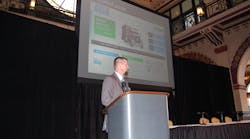INDIANAPOLIS. The trucking industry should experience slower freight growth over the next two years compared to the prior three, according to experts gathered here for FTR’s annual transportation conference, along with greater volatility as multiple federal regulatory initiatives begin to affect carrier operations.
“It’s really important for carriers to look at the risks,” explained Noel Perry, FTR’s senior consultant and president of research firm Transport Fundamentals. “We’re coming out of two relatively stable years so the return to volatility we’re projecting may be surprising. Now is the time to be vigilant.”
He added that trucking is also coming off what he calls a “low cost” period as well and expects the industry to witness “upward exposure” to cost increases over the next two years.
“In terms of cost the 2012-2013 period is an anomaly,” Perry said, mainly because the imposition of many potentially costly federal regulations – such as making electronic logging devices or ELDs mandated technology for all trucks – got delayed.
By comparison, in the 1990s, trucking experienced a 1% to 2% decline in costs, followed by a 4% rise in costs in the 2000s and an 8% spike in 2010-2011, mainly due to the imposition of emission control technology. Perry noted, however, that costs barely budged over zero in 2012-2013, but should now accelerate to between 2% and 3% in 2014.
By contrast, truckload freight volumes, which averaged 4% annual growth over the last three years, are expected to increase just 2% to 3% in 2014 and 2015 as the U.S. – and much of the world – continues to experience what Eli Lustgarten, senior vice president of Longbow Securities, characterized as “muddle through” rates of economic growth.
“In the first quarter U.S. GDP [gross domestic product] grew at 1.1%, with the second quarter at 1.7%, which may be revised up to 2%,” Lustgarten said. “That’s disappointing but we expect the same ‘muddle through’ type of growth pattern for the rest of this year and into the next.”
Bill Strauss, senior economist for the Federal Reserve Bank of Chicago, added that the outlook for the third quarter does not look much better as – according to the 3-month moving Chicago Fed National Activity Index – growth is weakening, suggesting that the economy will remain “challenged” in his estimation.
“While we will remain well away from a recessionary decline in 2014, growth rates won’t be setting anything on fire either,” he said. “Part of the reason growth is so muted is that businesses don’t feel they need to make major investments in order to capture opportunities. They are basically achieving their objectives with what they have in place.”
Yet it is the potential regulatory avalanche now facing trucking – a total of some 26 potential initiatives in all – that could really clip the industry’s wings, FTR’s Perry said.
“We are easily facing the largest collection of regulatory changes in the history of this industry, from ELDs to mandatory speed limits and safety fitness ratings,” he explained. “Hours of service (HOS) reform has been the single biggest shock to the system, reducing trucking productivity by 3% nationwide.”
And if all those 26 regulations proposed by a myriad of federal agencies are put into effect as advertised, Noel believes that will result in a shortage of 1 million to 1.4 million truck drivers.
There’s one other critical change underway when it comes to trucking regulations, warned Annette Sandberg, CEO of TransSafe Consulting and a former administrator of the Federal Motor Carrier Safety Administration (FMCSA): a trend by federal agencies to rely on “guidance” to make changes to industry practices.
“We’ve seen this trend developing over the last 6 to 8 months,” she explained. “Rather than spend 2 to 4 years – or even longer – going through the highly bureaucratic rulemaking process, there’s now an effort to rewrite all the guidance for current regulations. That imposes significant change as the guidance is what agencies hold carriers accountable for; it’s their [agency] interpretation of how the rules are to be followed.”



